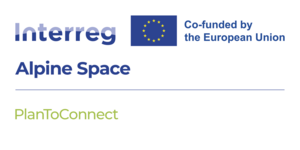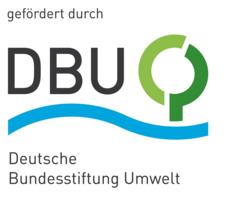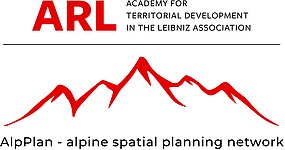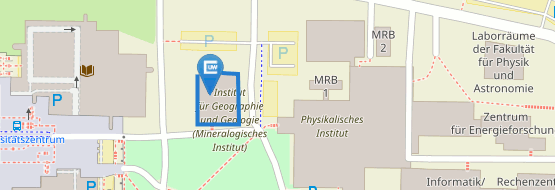Research

PlanToConnect – Mainstreaming ecological connectivity in spatial planning systems of the Alpine Space
- Funding body: Interreg Alpine Space Programme (European Regional Development Fund)
- Duration: 11/2022 – 10/2025
- Total project budget: 2.461.927,46 EUR
- Co-financing of the European Union: 1.846.445,59 EUR
- Subbudget JMU: 300.966,76 EUR (EU Co-financing: 225.725,07 EUR)
- Project website: https://www.alpine-space.eu/project/plantoconnect
- Leadership: Univ.-Prof. Dr. Hubert Job
- Contact person: Kerstin Ströbel, M. Sc., Constantin Meyer, M.Sc.
Promoting ecological connectivity is an important option to enable dynamic adaptation processes in ecosystems, and thus to combat the decline in biodiversity and preserve ecosystem functions, especially in view of the changing climatic conditions. While protected areas are well established, their connection through green and blue infrastructure/ecological corridors suffers from significant planning gaps, missing implementation and emerging threats, such as renewable energy production. An overarching connectivity planning concept guiding corridor implementation across alpine regions is currently missing. Therefore, regional networks, including design of corridors, need to be harmonized and planning systems upgraded to move from conventional land-use planning to more ecosystem function approaches. Know-how and experience developed by PlanToConnect and from previous Alpine Space projects (e.g. ALPBIONET2030, OpenSpaceAlps) will be applied to, and tested in, ecological network planning in the partner regions, a step towards the development of a coherent network of green and blue infrastructures throughout the Alpine Space. The PlanToConnect project comprises ten partner organisations from five Alpine countries.

Health-relevant effects of urban forest structures
- Funding body: Deutsche Forschungsgemeinschaft (DFG)
- Duration: 05/2022 – 04/2025
- Budget: 365.000 EUR
- Leadership and contact person: PD Dr. Joachim Rathmann
In the interdisciplinary project, the overall objective is to identify the different "structural types" of Augsburg's urban forest with its surroundings using different methods/techniques of the project partners (Prof. Dr. Elisabeth André. Chair for Human-Centered AI, PD Dr. Christoph Beck, Physical Geography with focus on climate research, University of Augsburg). Here, categories are to be determined that represent forest structural characteristics that are as clearly definable as possible with respect to local and human bioclimatic as well as other potentially health-relevant parameters. The relevant forest structure types will subsequently be characterized as comprehensively as possible with regard to their specific manifestations of health-relevant parameters – both local and human bioclimatic as well as non-climatic (subjective perception, human physiological effects).

Methodical advancement of regional economic impact analyses of nature tourism in the National Natural Landscapes of Germany: Application of the multi-regional input-output analysis
- Funding body: Deutsche Bundesstiftung Umwelt (DBU)
- Duration: 04/2022 – 09/2023
- Budget: 125.000 EUR
- Leadership: Univ.-Prof. Dr. Hubert Job
- Contact person: Dr. Lisa Majewski
Protected areas not only protect valuable natural and cultural landscapes but are significant economic drivers for regional and national economies. Nature tourism secures income and employment for the local population and strengthens local nature conservation. To understand the economic effects of nature tourism, numerous methods have been developed over time. In Germany, value added analysis has been used as standard in all studies so far. International research, on the other hand, uses the more detailed and thus more reliable input-output method to measure nature tourism multiplier effects. In this project, the methodology of regional economic impact analyses in Germany’s protected areas will be developed by conducting a multi-regional input-output analysis for Lower Saxony, Hamburg, and Schleswig-Holstein National Parks and UNESCO World Heritage Sites. The multi-regional input-output model allows a mapping of national input and consumption effects resulting from nature tourism spending in the study region. The findings are compared with simultaneously available results of value added analyses in the three protected area regions to derive methodological implications for the regional economic monitoring of protected areas.

Analysis of the regional economic effects of nature tourism in the nature park Lüneburger Heide
- Funding body: Alfred Toepfer Akademie für Naturschutz, Schneverdingen/Verein Naturparkregion Lüneburger Heide e.V., Amelinghausen
- Duration: 03/2022 – 09/2024
- Budget: 46.900 EUR
- Leadership: Univ.-Prof. Dr. Hubert Job
- Contact persons: Anna Frieser M.Sc., Dr. Manuel Woltering
The nature park Lüneburger Heide as the first nature park in Germany is particularly characterized by the interaction of natural and human influences. Formed by glacial processes and the agricultural use of the people, the characteristic heath landscape has developed there, which has had a special importance for the population in local recreation for a long time. So that the cultural landscape of the Lüneburg Heath can still be experienced today and can function as a habitat for many rare plant and animal species, efforts were already made at the beginning of the 20th century to protect it. The aim of the research is to quantify the economic significance of nature tourism in the nature park Lüneburger Heide.

ARL European Working Group "AlpPlan - alpine spatial planning network"
- Partner institution: Akademie für Raumentwicklung in der Leibniz-Gemeinschaft (ARL)
- Duration: Ongoing, since 10/2020
- Budget: Ongoing from budget for research and teaching
- Project website:: https://www.arl-international.com/activities/alpplan-network
- Leadership: Univ.-Prof. Dr. Hubert Job
- Contact person: Constantin Meyer, M.Sc.
AlpPlan is a European Working Group (EWG) in the Alpine region, resulting from a cooperation of the Interreg Alpine Space project OpenSpaceAlps and the Academy for Territorial Development in the Leibniz Association (ARL). The realisation of the objectives set by the Alpine Convention and their coordination by means of spatial planning form an important framework for the activities of the network. The overall objective of AlpPlan is to promote cooperation and coordination in the field of spatial planning in the Alpine region, especially from a cross-border perspective. Through mutual exchange and cooperation, the network is committed to contributing to sustainable territorial development from an ecological, economic and social perspective. The benefit of the network is seen particularly in the fact that AlpPlan brings together both scientific expertise and practice-oriented application perspectives.

Regional economic effects of sustainable tourism in nature parks and 'total economic valuation' of the National Natural Landscapes
- Funding body: UFOPLAN – BMU/Bundesamt für Naturschutz, Bonn
- Duration: 07/2020 – 12/2024
- Budget: 508.000 EUR
- Leadership: Univ.-Prof. Dr. Hubert Job
- Contact persons: Sarah Bittlingmaier, M.Sc., Anna Frieser, M.Sc., Dr. Lisa Majewski, Dr. Manuel Woltering
In recent years, almost all German national parks and biosphere reserves have now been analyzed with regard to their regional economic effects on the surrounding regions. The resulting data, such as the number of visitors per year or the proportion of guests coming because of the status as a protected area, are part of the Integrative Monitoring Program of the Federal Government and the Federal/State Working Group on Nature Conservation, Landscape Management and Recreation (LANA). For the category of nature parks, such an assessment of their importance for the tourism economy in Germany is still pending. Due to the large number of nature parks with more than 100 representatives, however, it is not possible to carry out a comprehensive case-by-case analysis. Instead, a nationwide statement is made on the basis of detailed knowledge of selected case studies by means of extrapolation. Furthermore, it is the aim of the project to carry out a 'total economic valuation' for the first time on the basis of the results on the economic importance of tourism as well as further analyses for all three categories of National Natural Landscapes.

Regional economic effects of tourism in the Schleswig-Holstein Wadden Sea National Park as a contribution to improved communication of natural values
- Funding body: Nationalparkstiftung Schleswig-Holstein
- Duration: 03/2021 - 03/2023
- Budget: 105.000 EUR
- Leadership: Univ.-Prof. Dr. Hubert Job
- Context persons: Sarah Bittlingmaier, M.Sc., Dr. Manuel Woltering
The Wadden Sea as a unique natural area with global significance for bird migration is a landscape worthy of protection. The designation as a national park aims to ensure an undisturbed operation of natural processes in their natural dynamics. In addition, it is intended to serve the scientific observation of the environment, natural history education and the experience of nature for the population. The North Frisian mainland, the islands and Halligen have always been a tourist highlight and highly frequented. In addition to the role of the national park as a travel motive, the study also aims to consider the growing role of the UNESCO biosphere reserve and the UNESCO World Natural Heritage designation in the analysis. The interest lies on the travel decisions of the visitors and their tourist expenditures in order to investigate the economic importance of tourism for the region. The first and so far only survey for the Schleswig-Holstein Wadden Sea took place in 2012 and now receives an update on new results on tourism development through a methodologically comparable study.
Regional economic effects of tourism in the Berchtesgadener Land Biosphere Reserve
- Funding body: Regierung von Oberbayern
- Duration: 01/2021 – 10/2022
- Budget: 65.000 EUR
- Leadership: Univ.-Prof. Dr. Hubert Job
- Contact persons: Sarah Bittlingmaier, M.Sc., Dr. Manuel Woltering
Regional economic effects of tourism in the Hamburg and Lower Saxony Wadden Sea National Parks
- Funding body: Nationalparkverwaltungen Hamburgisches und Niedersächsisches Wattenmeer
- Duration: 12/2018 – 09/2022
- Budget: 135.000 EUR
- Leadership: Univ.-Prof. Dr. Hubert Job
- Contact persons: Sarah Bittlingmaier, M.Sc., Dr. Manuel Woltering
OpenSpaceAlps – Sustainable development of alpine open spaces by enhancing spatial planning governance
- Funding body: Interreg Alpine Space Programm (Europäischer Fonds für regionale Entwicklung)
- Duration: 10/2019 – 06/2022
- Budget: 128.000 EUR
- Leadership: Univ.-Prof. Dr. Hubert Job
- Contact person: Constantin Meyer, M.Sc.
Determining the socio-economic effects of tourism in German UNESCO biosphere reserves
- Funding body: UFOPLAN – BMUB/Bundesamt für Naturschutz, Bonn
- Duration: 04/2016 – 05/2022
- Budget: 545.000 EUR
- Leadership: Univ.-Prof. Dr. Hubert Job
- Contact persons: Dr. Manuel Engelbauer, Dr. Lisa Majewski, Dr. Manuel Woltering
Biodiversity and ecosystem services of forests with a focus on wood: new ways of sustainable use in the context of ecology, economy and climate change (BioHolz)
- Funding body: BMUB/BMBF, Berlin
- Duration: 07/2015 – 06/2021
- Budget: 438.000 EUR
- Leadership: Univ.-Prof. Dr. Hubert Job
- Contact person: PD Dr. Joachim Rathmann
Potential analysis of nature tourism in the Black Forest Biosphere Region
- Funding body: Deutsche Bundesstiftung Umwelt (DBU); Osnabrück
- Duration: 07/2015 – 06/2021
- Budget: 125.000 EUR
- Leadership: Univ.-Prof. Dr. Hubert Job
- Contact person: Dr. Lisa Majewski
Park-people relationships of the Berchtesgaden National Park
- Funding body: Nationalparkverwaltung Berchtesgaden
- Duration: 01/2018 – 12/2018
- Budget: 48.500 EUR
- Leadership: Univ.-Prof. Dr. Hubert Job
- Contact persons: Sarah Bittlingmaier, M.Sc., Dr. Manuel Woltering
Park-people relationships of the Bavarian Forest National Park
- Funding body: Nationalparkverwaltung Bayerischer Wald
- Duration: 06/2017 – 09/2018
- Budget: 48.500 EUR
- Leadership: Univ.-Prof. Dr. Hubert Job
- Contact persons: Sarah Bittlingmaier, M.Sc., Dr. Manuel Woltering
Current and potential regional economic effects of nature tourism in the nature parks Kyffhäuser and Südharz
- Funding body: Thüringer Ministerium für Umwelt, Energie und Naturschutz
- Duration: 10/2016 – 03/2018
- Budget: 116.000 EUR
- Leadership: Univ.-Prof. Dr. Hubert Job
- Contact persons: Dr. Manuel Engelbauer, Dr. Manuel Woltering
Socio-economic evaluation of possible national park regions
- Funding body: Bayerisches Staatsministerium für Umwelt und Verbraucherschutz
- Duration: 04/2017 – 07/2017
- Budget: 40.000 EUR
- Leadership: Univ.-Prof. Dr. Hubert Job
- Contact persons: Dr. Manuel Engelbauer, Dr. Manuel Woltering
National parks, nature tourism and demographic change in Germany: Potential effects on visitor frequency, structures and spatiotemporal movement patterns
- Funding body: Deutsche Forschungsgemeinschaft (DFG), Bonn
- Duration: 07/2014 – 06/2016
- Budget: 147.000 EUR
- Leadership: Univ.-Prof. Dr. Hubert Job
- Contact person: Dr. Johannes Schamel


